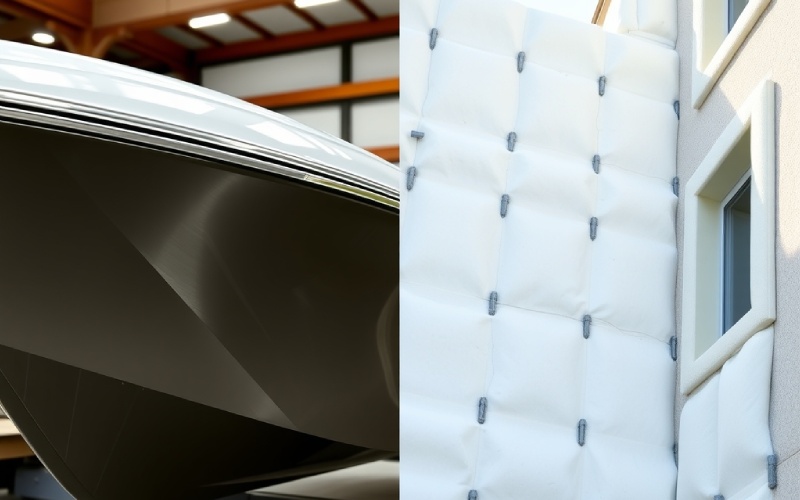Lassen Sie sich von Istar mit unserer Erfahrung und unserem Know-how beim Start Ihres Projekts unterstützen!
Laden Sie Ihre Designdateien und Produktionsanforderungen hoch und wir melden uns innerhalb von 30 Minuten bei Ihnen!

I bet when you hear “fiberglass,” you think of the fluffy pink stuff in your home’s attic. You are right about that. That is one type of fiberglass used for insulation. But there is a whole world of fiberglass that is strong and light. It is used in things you see and use all the time. I have worked with this amazing material for many years. I want to share what I have learned with you. This article will show you how fiberglass is made. It will also show you all the great things we can do with it. You will be amazed at how much there is to know about this simple but very special material.
Let me tell you, fiberglass is a really neat material. It is a type of plastic made stronger with glass fibers. Think about it this way. A piece of plastic by itself might not be very strong. But if you mix in very small, thin strings of glass, you get something much stronger. This mix is called a composite material. The glass fibers give the plastic great strength. The plastic, which is usually a resin, holds all the fibers together and gives the object its shape.
You might hear people call it other names, like glass-reinforced plastic (GRP). It means the same thing. No matter the name, the basics are the same. We take very fine fibers of glass. We mix them with a liquid plastic called a resin. What we get is a material that is not only strong but also very lightweight. In fact, it can be stronger than many metals for the same weight. This special property is why we use it for so many different things. We use it to build a boat or to make a surfboard.
It is pretty cool to think that we can take simple glass and turn it into the strong material we know as fiberglass. The work starts by melting a special mix of materials. This is not the same glass you find in a bottle or a window. The recipe has things like silica sand, limestone, and kaolin clay. These are measured just right and mixed together. Then they go into a very hot oven.
After the mix turns into molten glass, it is pushed through a machine with many tiny holes. This makes very thin strings of glass called filaments. These glass fiber filaments are super thin. Then, the filaments are grouped together to make a ‘roving’. A roving looks like a big spool of thick thread. From there, the roving can be used in many ways to manufacture different fiberglass items. It can be woven to make cloth. Or it can be chopped into short pieces to make a mat. This first part of the manufacture process is very important for making the different kinds of reinforcement used in fiberglass composites.

I have learned that there are many kinds of fiberglass. There are several different types. Each one has its own special property that makes it good for certain jobs. The most common type is E-Glas. The “E” stands for electrical. As you can guess, it is very good at stopping electricity. It is the normal, do-it-all fiberglass. We use it in everything from boats to computer parts.
Then we have S-Glas. The “S” stands for structural. This type is much stronger than E-glass. You can think of it as the super-strong version of fiberglass. You will find S-glass used in things that need a lot of tensile strength, like in airplanes. There are other types, too. C-Glas is good at resisting chemicals. A-Glas is also known as alkali glass. We even have R-glass und T-glass for other special jobs. Knowing the different types helps a manufacturer pick the right fiberglass for the job. It could be for building a chemical tank or a part for a fast airplane.
| Glas Typ | Key Property | Häufige Verwendungszwecke |
|---|---|---|
| E-Glas | Stops electricity, is strong | Boats, insulation, circuit boards |
| S-Glas | Very high tensile strength | Airplanes, army gear |
| C-Glas | Widersteht Chemikalien | Chemische Lagertanks |
| A-Glas | Resists alkali | Fabrikmaschinen |
The reason fiberglass works so well is because of its great properties. One of the best is its high tensile strength. This means you can pull on it with a lot of force before it will crack or break. It is also very lightweight. This is a big help in many products. Think about a boat or an automotive part. Being lightweight helps save gas and makes them go faster.
Another great property of fiberglass is that it is very durable and resistant to many things. It does not rust like metal does. That is why it is used so much for things in the water, in marine uses. It is also resistant to many chemicals. This makes it perfect for a tank or pipe that holds corrosive chemicals. On top of that, fiberglass is a great insulator. It can stop both heat and electricity. This mix of being strong, light, and resistant makes fiberglass the right material for so many industrial products and building materials.
Making a boat is a great way to see how we use fiberglass to make big, strong things that last. The work often starts with a mold that is in the shape of the boat’s body, or hull. The first coat put in the mold is the gelcoat. This is a special kind of resin. It gives the boat its smooth, colored surface. After the gelcoat is there, the lay-up work starts.
This is when the fiberglass is added. Workers will lay a sheet of fiberglass cloth or chopped strand mat in the mold. Then, they will pour a liquid resin over it. The resin soaks into the glass fiber. When the resin gets hard, or cures, it makes a strong, solid piece of fiberglass. They do this again and again. They build up layers of fiberglass and resin until the boat hull is thick and strong enough. Sometimes, they use a method called spray-up. A special gun sprays a mix of chopped glass fiber and resin into the mold. This can be a faster way to build the layers of the fiberglass hull.
When I first started to work with fiberglass, I learned fast about chopped strand mat, or CSM. CSM is a type of fiberglass reinforcement. It is made from short pieces of glass fiber. The pieces are pointed in all directions and held together with a type of glue. It comes in a sheet or a roll. It is a very important component in many fiberglass jobs.
One great thing about chopped strand mat is that it is very flexible. It can bend to fit into tricky shapes and corners. This makes it great for the first few layers of a lay-up. It helps to hide the pattern of the woven fabrics so you do not see it on the finished surface. CSM is often used to make a fiberglass part thicker and stronger. Because the fibers point in every direction, the final part is just as stiff all around. This gives it good structural support. For any hand lay-up or spray-up job, CSM is a key material.
The glass fibers in fiberglass give it strength. But it is the resin that holds it all together and gives it a shape. You can think of it as the glue that turns loose glass fiber into a solid, strong composite material. The most common kind of resin used with fiberglass is polyester resin. It does not cost a lot, and it is easy to use. There are other kinds, too. Vinyl ester resin is better at resisting chemicals. Epoxy resin is the strongest and lasts the longest.
The resin starts as a liquid. To make it get hard, we add a chemical called a catalyst. This starts a reaction that causes the resin to cure, or become a solid. The act of putting resin on the fiberglass reinforcement is called “wetting out.” It is very important to make sure the resin soaks all the way into the glass fiber. This makes a very strong connection. This mix of fiberglass and resin is what lets us make everything from a small, flexible surfboard to a huge, structural tank.

Yes, you sure can, and it is a very common choice for a place to swim! A fiberglass pool is made in a factory using a mold, just like a boat. The work starts by spraying a special gelcoat into the mold. This will become the smooth inside surface of the pool. This gelcoat is resistant to green stuff like algae and also to chemicals. This is great for keeping your pool clean.
After the gelcoat, layers of chopped fiberglass and resin are put in to build the pool’s shell. A manufacturer will use a mix of chopped strand mat. Sometimes they use woven roving for extra strength in areas that take a lot of stress. Using a good vinyl ester resin for the first few layers helps make a wall that water cannot get through. Once it is thick enough, the fiberglass shell is left to cure and get hard. Then, it is taken out of the mold with great care. The result is a one-piece, durable pool. It can be moved to your yard and put in the ground. This process makes a strong and long-lasting pool for you to swim in and enjoy for many years.
I have seen for myself how fiberglass can be used for many things in building. One of its best points is that it is very strong for how light it is. It is much lighter than materials like steel or concrete. But it still offers great strength and lasts a long time. This makes handling and putting in fiberglass components at a work site much easier. Think about big panels for the outside of a building or for a roof. Using lightweight fiberglass can reduce the weight the building has to hold up.
Fiberglass is also very resistant to weather. It will not rot like wood. It will not rust like steel. This makes it a great choice for things that stay outside. It is also a wonderful insulation material. The fluffy fiberglass insulation you know works by trapping air. This helps to reduce heat from moving through it. But even solid fiberglass composites do not let heat pass through them well. This can help to insulate buildings. From making concrete stronger to making pretty panels for buildings, fiberglass has become a very important material in building today.
Once you start to look, you will find fiberglass in many places. The automotive industry uses it for car bodies, bumpers, and other components. It is used because it is lightweight and can be made into many shapes. Many fun items are made with fiberglass, like surfboards, skis, and fishing rods. Companies that build airplanes also count on fiberglass to manufacture parts for their planes and other gear.
In factories, you will find fiberglass used for pipes, tanks, and housing for machines. This is because it does not get damaged by rust or chemicals and is very durable. Even phone and internet companies use fiberglass. They make boxes for their gear because it does not block radio signals. And of course, you will find it in your house. It is used in things like bathtubs, showers, and doors. It can be used for so many things. From keeping us safe in a car to helping us have fun on the water, fiberglass is a material that plays a big, quiet part in our lives.